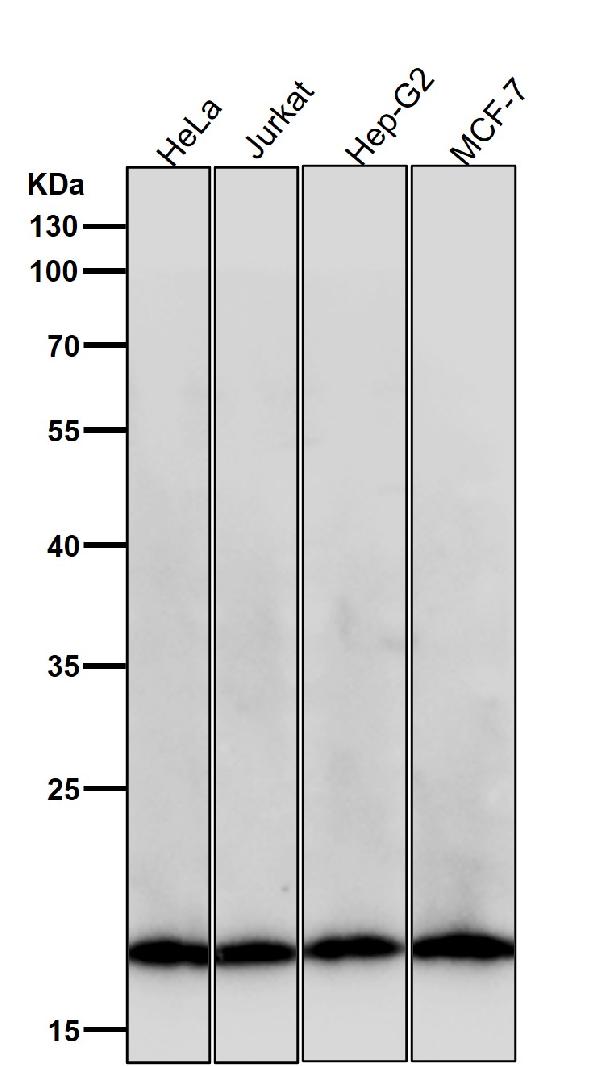Anti-Pleiotrophin Rabbit Monoclonal Antibody
- SPECIFICATION
- CITATIONS
- PROTOCOLS
- BACKGROUND

Application
| WB |
|---|---|
| Primary Accession | P21246 |
| Host | Rabbit |
| Isotype | Rabbit IgG |
| Reactivity | Rat, Human, Mouse |
| Clonality | Monoclonal |
| Format | Liquid |
| Description | Anti-Pleiotrophin Rabbit Monoclonal Antibody . Tested in WB applications. This antibody reacts with Human, Mouse, Rat. |
| Gene ID | 5764 |
|---|---|
| Other Names | Pleiotrophin, PTN, Heparin-binding brain mitogen, HBBM, Heparin-binding growth factor 8, Heparin-binding neurite outgrowth-promoting factor, HBNF, Heparin-binding neurite outgrowth-promoting factor 1, HBNF-1, Osteoblast-specific factor 1, OSF-1, PTN (HGNC:9630), HBNF1, NEGF1 |
| Calculated MW | 18942 Da |
| Application Details | WB 1:500-1:2000 |
| Contents | Rabbit IgG in phosphate buffered saline, pH 7.4, 150mM NaCl, 0.02% sodium azide and 50% glycerol, 0.4-0.5mg/ml BSA. |
| Clone Names | Clone: 32P54 |
| Immunogen | A synthesized peptide derived from human Pleiotrophin |
| Purification | Affinity-chromatography |
| Storage | Store at -20°C for one year. For short term storage and frequent use, store at 4°C for up to one month. Avoid repeated freeze-thaw cycles. |
| Name | PTN (HGNC:9630) |
|---|---|
| Synonyms | HBNF1, NEGF1 |
| Function | Secreted growth factor that mediates its signal through cell- surface proteoglycan and non-proteoglycan receptors (PubMed:11278720, PubMed:16814777, PubMed:19141530). Binds cell-surface proteoglycan receptor via their chondroitin sulfate (CS) groups (PubMed:26896299, PubMed:27445335). Thereby regulates many processes like cell proliferation, cell survival, cell growth, cell differentiation and cell migration in several tissues namely neuron and bone (PubMed:11278720, PubMed:1733956, PubMed:1768439, PubMed:19141530, PubMed:19442624, PubMed:27445335, PubMed:30667096). Also plays a role in synaptic plasticity and learning-related behavior by inhibiting long-term synaptic potentiation (By similarity). Binds PTPRZ1, leading to neutralization of the negative charges of the CS chains of PTPRZ1, inducing PTPRZ1 clustering, thereby causing the dimerization and inactivation of its phosphatase activity leading to increased tyrosine phosphorylation of each of the PTPRZ1 substrates like ALK, CTNNB1 or AFAP1L2 in order to activate the PI3K-AKT pathway (PubMed:10706604, PubMed:16814777, PubMed:17681947, PubMed:27445335, PubMed:30667096). Through PTPRZ1 binding controls oligodendrocyte precursor cell differentiation by enhancing the phosphorylation of AFAP1L2 in order to activate the PI3K-AKT pathway (PubMed:27445335, PubMed:30667096). Forms a complex with PTPRZ1 and integrin alpha-V/beta-3 (ITGAV:ITGB3) that stimulates endothelial cell migration through SRC dephosphorylation and activation that consequently leads to ITGB3 'Tyr-773' phosphorylation (PubMed:19141530). In adult hippocampus promotes dendritic arborization, spine development, and functional integration and connectivity of newborn granule neurons through ALK by activating AKT signaling pathway (By similarity). Binds GPC2 and chondroitin sulfate proteoglycans (CSPGs) at the neuron surface, leading to abrogation of binding between PTPRS and CSPGs and neurite outgrowth promotion (By similarity). Binds SDC3 and mediates bone formation by recruiting and attaching osteoblasts/osteoblast precursors to the sites for new bone deposition (By similarity). Binds ALK and promotes cell survival and cell proliferation through MAPK pathway activation (PubMed:11278720). Inhibits proliferation and enhances differentiation of neural stem cells by inhibiting FGF2-induced fibroblast growth factor receptor signaling pathway (By similarity). Mediates regulatory mechanisms in normal hemostasis and in hematopoietic regeneration and in maintaining the balance of myeloid and lymphoid regeneration (By similarity). In addition may play a role in the female reproductive system, auditory response and the progesterone-induced decidualization pathway (By similarity). |
| Cellular Location | Secreted |
| Tissue Location | Osteoblast and brain.. |

Thousands of laboratories across the world have published research that depended on the performance of antibodies from Abcepta to advance their research. Check out links to articles that cite our products in major peer-reviewed journals, organized by research category.
info@abcepta.com, and receive a free "I Love Antibodies" mug.
Provided below are standard protocols that you may find useful for product applications.
If you have used an Abcepta product and would like to share how it has performed, please click on the "Submit Review" button and provide the requested information. Our staff will examine and post your review and contact you if needed.
If you have any additional inquiries please email technical services at tech@abcepta.com.













 Foundational characteristics of cancer include proliferation, angiogenesis, migration, evasion of apoptosis, and cellular immortality. Find key markers for these cellular processes and antibodies to detect them.
Foundational characteristics of cancer include proliferation, angiogenesis, migration, evasion of apoptosis, and cellular immortality. Find key markers for these cellular processes and antibodies to detect them. The SUMOplot™ Analysis Program predicts and scores sumoylation sites in your protein. SUMOylation is a post-translational modification involved in various cellular processes, such as nuclear-cytosolic transport, transcriptional regulation, apoptosis, protein stability, response to stress, and progression through the cell cycle.
The SUMOplot™ Analysis Program predicts and scores sumoylation sites in your protein. SUMOylation is a post-translational modification involved in various cellular processes, such as nuclear-cytosolic transport, transcriptional regulation, apoptosis, protein stability, response to stress, and progression through the cell cycle. The Autophagy Receptor Motif Plotter predicts and scores autophagy receptor binding sites in your protein. Identifying proteins connected to this pathway is critical to understanding the role of autophagy in physiological as well as pathological processes such as development, differentiation, neurodegenerative diseases, stress, infection, and cancer.
The Autophagy Receptor Motif Plotter predicts and scores autophagy receptor binding sites in your protein. Identifying proteins connected to this pathway is critical to understanding the role of autophagy in physiological as well as pathological processes such as development, differentiation, neurodegenerative diseases, stress, infection, and cancer.



